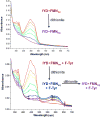The distribution and mechanism of iodotyrosine deiodinase defied expectations
- PMID: 28774660
- PMCID: PMC5665059
- DOI: 10.1016/j.abb.2017.07.019
The distribution and mechanism of iodotyrosine deiodinase defied expectations
Abstract
Iodotyrosine deiodinase (IYD) is unusual for its reliance on flavin to promote reductive dehalogenation under aerobic conditions. As implied by the name, this enzyme was first discovered to catalyze iodide elimination from iodotyrosine for recycling iodide during synthesis of tetra- and triiodothyronine collectively known as thyroid hormone. However, IYD likely supports many more functions and has been shown to debrominate and dechlorinate bromo- and chlorotyrosines. A specificity for halotyrosines versus halophenols is well preserved from humans to bacteria. In all examples to date, the substrate zwitterion establishes polar contacts with both the protein and the isoalloxazine ring of flavin. Mechanistic data suggest dehalogenation is catalyzed by sequential one electron transfer steps from reduced flavin to substrate despite the initial expectations for a single two electron transfer mechanism. A purported flavin semiquinone intermediate is stabilized by hydrogen bonding between its N5 position and the side chain of a Thr. Mutation of this residue to Ala suppresses dehalogenation and enhances a nitroreductase activity that is reminiscent of other enzymes within the same structural superfamily.
Keywords: Dehalogenase; Flavin; Iodide salvage; Reductive dehalogenation; Thyroid.
Copyright © 2017 Elsevier Inc. All rights reserved.
Figures












Similar articles
-
A switch between one- and two-electron chemistry of the human flavoprotein iodotyrosine deiodinase is controlled by substrate.J Biol Chem. 2015 Jan 2;290(1):590-600. doi: 10.1074/jbc.M114.605964. Epub 2014 Nov 13. J Biol Chem. 2015. PMID: 25395621 Free PMC article.
-
Polar Interactions between Substrate and Flavin Control Iodotyrosine Deiodinase Function.Biochemistry. 2024 Sep 17;63(18):2380-2389. doi: 10.1021/acs.biochem.4c00357. Epub 2024 Aug 30. Biochemistry. 2024. PMID: 39213510
-
Crystal structure of iodotyrosine deiodinase, a novel flavoprotein responsible for iodide salvage in thyroid glands.J Biol Chem. 2009 Jul 17;284(29):19659-67. doi: 10.1074/jbc.M109.013458. Epub 2009 May 12. J Biol Chem. 2009. PMID: 19436071 Free PMC article.
-
Efficient use and recycling of the micronutrient iodide in mammals.Biochimie. 2010 Sep;92(9):1227-35. doi: 10.1016/j.biochi.2010.02.013. Epub 2010 Feb 16. Biochimie. 2010. PMID: 20167242 Free PMC article. Review.
-
New insights into the structure and mechanism of iodothyronine deiodinases.J Mol Endocrinol. 2015 Dec;55(3):R37-52. doi: 10.1530/JME-15-0156. Epub 2015 Sep 21. J Mol Endocrinol. 2015. PMID: 26390881 Review.
Cited by
-
Substrate Electronics Dominate the Rate of Reductive Dehalogenation Promoted by the Flavin-Dependent Iodotyrosine Deiodinase.Biochemistry. 2023 Apr 4;62(7):1298-1306. doi: 10.1021/acs.biochem.3c00041. Epub 2023 Mar 9. Biochemistry. 2023. PMID: 36892456 Free PMC article.
-
Light-driven Oxidative Demethylation Reaction Catalyzed by a Rieske-type Non-heme Iron Enzyme Stc2.ACS Catal. 2022 Dec 2;12(23):14559-14570. doi: 10.1021/acscatal.2c04232. Epub 2022 Nov 14. ACS Catal. 2022. PMID: 37168530 Free PMC article.
-
Identification of Signature Genes in the PD-1 Relative Gastric Cancer Using a Combined Analysis of Gene Expression and Methylation Data.J Oncol. 2022 Dec 15;2022:4994815. doi: 10.1155/2022/4994815. eCollection 2022. J Oncol. 2022. PMID: 36568638 Free PMC article.
-
Informing Efforts to Develop Nitroreductase for Amine Production.Molecules. 2018 Jan 24;23(2):211. doi: 10.3390/molecules23020211. Molecules. 2018. PMID: 29364838 Free PMC article.
-
Sitagliptin Modulates Oxidative, Nitrative and Halogenative Stress and Inflammatory Response in Rat Model of Hepatic Ischemia-Reperfusion.Antioxidants (Basel). 2021 Jul 22;10(8):1168. doi: 10.3390/antiox10081168. Antioxidants (Basel). 2021. PMID: 34439416 Free PMC article.
References
-
- Williams GR. Neurodevelopmental and neurophysiological actions of thyroid hormone. J. Neuroendocrin. 2008;20:784–794. - PubMed
-
- Bianco AC, Salvatore D, Gereben B, Berry MJ, Larsen PR. Biochemistry, cellular and molecular biology and physiological roles of the iodothyronine selenodeiodinases. Endocrine Rev. 2002;23:38–89. - PubMed
Publication types
MeSH terms
Substances
Grants and funding
LinkOut - more resources
Full Text Sources
Other Literature Sources
Research Materials

